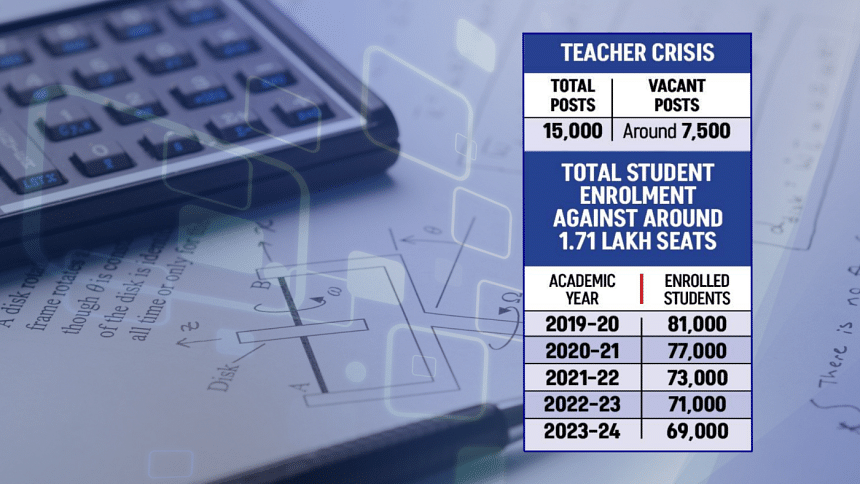Technical education hit by teacher shortage, falling enrolment

Bangladesh's technical education sector is facing a slow-burning crisis, shaped by a severe shortage of teachers, poor infrastructure, and steadily declining student interest.
Despite government ambitions to expand the country's skilled workforce, the system continues to suffer from years of neglect and underinvestment, say experts.
More than half of the 15,000 sanctioned teaching posts in government and private technical institutions were vacant as of May this year, according to Bangladesh Technical Education Board (BTEB). In many polytechnic institutes, one teacher is tasked with teaching over 100 students across multiple shifts, a workload that undermines effective teaching.
The scale of the problem is starkly illustrated by the example of Faridpur Polytechnic Institute. With over 4,000 students enrolled in six departments, the institute needs 201 teachers to function effectively but operates with only 55. There is also a shortage of technical support staff, as 54 out of 128 positions remain vacant.
The situation is similar at Rajshahi Polytechnic Institute, which has 113 teachers for 3,392 students.
Md Abu Hanif, principal of the institute, said that more than half of the 240 teaching positions remain vacant, putting additional burden on the existing faculty.
"But we have somewhat grown accustomed to this. The situation was even worse in the past. In January, 54 teachers joined the institute, easing the burden on the existing staff.
"Previously, a teacher had to conduct 50-60 classes per week. Now, the number has come down to 20-25," he added.
The crisis in the sector is compounded by a sharp drop in enrolment. In 2023-24 academic year, only 69,000 students enrolled in diploma courses against 1.71 lakh seats, leaving nearly 60 percent of the seats vacant.
The downward trend has been consistent since 2020. Enrolment dropped to 77,272 in 2020-21 from 81,076 in 2019-20, further falling to 73,272 in 2021-22, and 71,553 in 2022-23. Private polytechnics dealt the harshest blow, enrolling only 30,136 students against 1.28 lakh seats last year. Even government polytechnics failed to fill the seats as only 38,644 students got admitted against a capacity of 43,500.
This is not limited to diploma courses only. At the SSC (vocational) level, out of 4.97 lakh seats, more than three lakh remained unfilled last year. HSC (Vocational) admissions reflect a similar decline.
If this pattern persists, it will be difficult for the government to achieve its goal of raising technical education enrolment to 30 percent by 2030.
Back in 2012, the government set an initial target of achieving 20 percent enrolment by 2020. At the time, only 3 percent of students enrolled in technical institutions. Though the figure rose to nearly 16 percent by 2020, the growth has since stagnated.
Experts blame it on years of neglect, inadequate investment, and the failure to modernise the system.
"Our current system produces underprepared and underpaid graduates. If we do not act now, Bangladesh risks missing its demographic dividend," said Debapriya Bhattacharya, distinguished fellow at the Centre for Policy Dialogue (CPD), at a recent event.
He called for urgent reforms under the supervision of a high-level national taskforce, emphasising that technical education must be treated as a core development priority, not a second-tier system.
M Kaykobad, former professor at Bangladesh University of Engineering and Technology, said, "The authorities often claim that they are working to improve the system but there is hardly any visible progress. How can students learn technical skills without good teachers and robust infrastructure?"
Frustration among students led to protests in Dhaka and several other districts in April. They pressed home a six-point demand including curriculum reforms, gradual introduction of English as the medium of instruction, establishment of a technical university, and quota in government jobs.
Talking to this newspaper, Rafiul Hasan, a third-year student at Jhenaidah Polytechnic Institute, said, "We have been told that technical education is the future, but how can we prepare for that future when our labs don't have basic equipment?"
Mashfik Islam, a student at Dhaka Polytechnic Institute, said, "We have long been demanding an updated curriculum. At the very least, the authorities should introduce English as the medium of instruction."
A recent CPD study, conducted in Panchagarh, Sunamganj, and Satkhira, found that though many technical graduates get jobs within six months of completing studies, most of them earn low wages.
Around 63 percent of respondents said they earned less than Tk 10,000 per month, while 36 percent got between Tk 15,000 and Tk 25,000. Poor infrastructure and low income were identified as key factors contributing to students' declining interest in technical education.
At a recent programme, Education Adviser Prof CR Abrar said, "There is a severe shortage of trade-related instructors and a lack of modern technologies in our institutions. Integrating technical education into the mainstream is crucial to dispel the widespread perception that it only produces low-grade technicians. This mindset must change."
BTEB Chairman Md Ruhul Amin acknowledged the challenges, attributing the drop in enrolment to pandemic-induced disruptions and financial hardship.
He also admitted that the process of teacher recruitment remains slow, often taking two to three years.
"We have recently taken steps to expedite the recruitment process. Our focus is now on improvement of teachers' training and education quality," he told The Daily Star.
In reply to a query, he said, "From the next academic year, students will have the option to choose between Bangla and English as the medium of instruction."

 For all latest news, follow The Daily Star's Google News channel.
For all latest news, follow The Daily Star's Google News channel. 








Comments